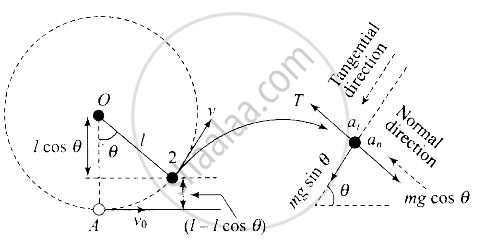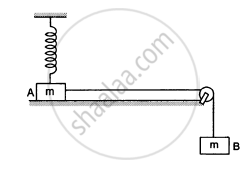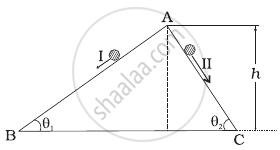Advertisements
Advertisements
प्रश्न
A bob of mass m suspended by a light string of length L is whirled into a vertical circle as shown in figure. What will be the trajectory of the particle if the string is cut at
- Point B?
- Point C?
- Point X?

उत्तर
According to the situation shown above when a bob of mass m is whirled into a vertical circle, the required centripetal force is obtained from the net force towards the center at any point of time in the string. Tension in the string is variable and it is always towards center. But the gravitational force on the bob is always towards center. The speed of the body will be different at different points. So the equations of dynamical equilibrium (Fc = mac, Ft = mat) must be satisfied at all the points. Let when the string makes an angle of 9 with vertical, the speed of mass is v.
Apply Newton’s law perpendicular to the string:
Mg sin = ma, ⇒ a,= g sin
The above equation gives tangential acceleration as a function of the angle. At lowest point = 0° and at highest point = 180°. So at both points sin 9 = 0. Hence a, = 0 at both points L and H.
At point M, = 90°, then a1 = g. It is the maximum value of at
Apply Newton’s law along the string: T – mg cos = mac
or T = mgcos + mv2/r ......(i)
As the body goes up, its velocity will go on decreasing and angle θ will go on increasing. The maximum speed of the body will be at the lowest point L and minimum at the highest point H. Then from the above relation we can find that tension will be maximum at the lowest point and minimum at the highest point.
Tension at the lowest point (θ – 0°, v = vL): TL = `mg + m v_L^2/r` ......(ii)
Tension at the highest point (θ – 180°, v = vH): TH = `mg + m v_H^2/r` ......(iii)

When a string is cut, the tension in string becomes zero and centripetal force is not provided. Hence, the bob tends to move in along the direction of its velocity.
- If the string is cut at any point, then velocity of the body of mass m is along the tangent to the circle. A tangent at point B is vertically downward so the trajectory of the particle is a straight line.
- The tangent at point C is horizontally towards the right.
So the trajectory of the particle is the parabola. - The tangent at point X makes some angle with the horizontal. Again bob will follow a parabolic path with a vertex higher than C.

APPEARS IN
संबंधित प्रश्न
A body is initially at rest. It undergoes one-dimensional motion with constant acceleration. The power delivered to it at time t is proportional to ______.
Two inclined frictionless tracks, one gradual and the other steep meet at A from where two stones are allowed to slide down from rest, one on each track . Will the stones reach the bottom at the same time? Will they reach there with the same speed? Explain. Given θ1 = 30°, θ2 = 60°, and h = 10 m, what are the speeds and times taken by the two stones?

Figure shows a particle sliding on a frictionless track which terminates in a straight horizontal section. If the particle starts slipping from point A, how far away from the track will the particle hit the ground?

A small heavy block is attached to the lower end of a light rod of length l which can be rotated about its clamped upper end. What minimum horizontal velocity should the block be given so that it moves in a complete vertical circle?

In the following figure shows two blocks A and B, each of mass of 320 g connected by a light string passing over a smooth light pulley. The horizontal surface on which the block Acan slide is smooth. Block A is attached to a spring of spring constant 40 N/m whose other end is fixed to a support 40 cm above the horizontal surface. Initially, the spring is vertical and unstretched when the system is released to move. Find the velocity of the block A at the instant it breaks off the surface below it. Take g = 10 m/s2.

A particle is released from height S from the surface of the Earth. At a certain height, its kinetic energy is three times its potential energy. The height from the surface of the earth and the speed of the particle at that instant are respectively ______
A body is falling freely under the action of gravity alone in vacuum. Which of the following quantities remain constant during the fall?
Two inclined frictionless tracks, one gradual and the other steep meet at A from where two stones are allowed to slide down from rest, one on each track as shown in figure.

Which of the following statement is correct?
Which of the diagrams shown in figure represents variation of total mechanical energy of a pendulum oscillating in air as function of time?
A body falls towards earth in air. Will its total mechanical energy be conserved during the fall? Justify.
